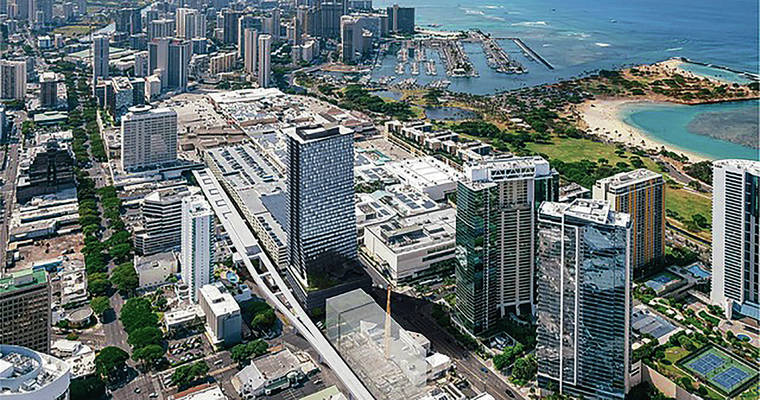City officials say that in exchange for allowing the planned 583-unit Ala Moana Plaza Opens in a new tab rental tower to be built, they want developer Brookfield Properties to give up easement parcels on the fringes of Ala Moana Center to accommodate bus service as well as the upcoming rail line.
Meanwhile, residents of neighboring condominium buildings are voicing concerns about the potential for increased traffic and the loss of view planes and property values as construction, and trade unions say they support the project as well as the housing and jobs it would bring.
The City Council Zoning, Planning and Housing Committee on Wednesday gave tentative approval for the project at Piikoi and Kona streets, but committee members indicated a lot of work needs to be done before it gets final approval. Wednesday’s action sent Resolution 20-315 Opens in a new tab to the full Council for a tentative vote next week.
The resolution provides Brookfield an Interim Planned Development — Transit permit allowing the developer to build up to 400 feet in height, up from the current 100-foot height limit, and at a 7.0 floor area ratio from the existing 2.5 FAR. Floor area ratio, the total floor area of the building divided by the size of the lot, is also what some describe as density.
Brookfield is also seeking exemptions from height setback, landscaping and parking requirements typical for the community business mixed-use zoning designation it now holds.
Brookfield is agreeing to rent 124 of the units, about 20%, to families and individuals who meet federal lower-income housing eligibility levels Opens in a new tab for at least 45 years.
Ala Moana has for decades been the busiest transit hub in the state, but most of the major streets in and around the complex are owned by Brookfield. The city is eyeing a site on Kona and Kona Iki streets, just several hundred feet from the planned tower, as the location of the 20-mile rail line’s final eastern stop.
Jon Nouchi, acting director of the Department of Transportation Services, explained to Council members that while the city generally has right-of-entry agreements when its buses access private property, there is always a concern that owners could revoke that access at any time.
While Brookfield has expressed a willingness to incorporate bus and rail into its long-term plan, that hasn’t always been the case with previous owners and there’s no certainty that cooperation would continue, especially if ownership was to change hands again, Nouchi said.
Area Councilman Tommy Waters, who proposed the changes on behalf of DTS, and Council Transportation Chairman Brandon Elefante said they also support including the easements as a requirement.
Waters said he’s worried that including the easements would be a deal breaker for the development and wants the matter hashed out further.
“What I’m concerned about is that Brookfield may not build the building if we do include those easements,” Waters told colleagues. Nonetheless, he said, the proposal asks Brookfield “to help us, help us build the rail station, give us the easements that otherwise would cost taxpayers … we’ve determined that it’s millions of dollars … but this is the perfect giveback.”
In exchange, Waters said, he’s willing to go so far as to support a 400-foot height limit and greater density throughout the Ala Moana property. “Because they’re helping us, they’re defraying from the cost of rail.”
The property owner already has agreed to provide some easements along Kona and Kona Iki, but the city wants more.
Kris Hui, Brookfield vice president of mixed-use development, voiced reservations about including the additional easements, pointing out that discussions about those should occur separately.
Through the 60 years of Ala Moana’s existence, the owners have always embraced buses and public transportation, Hui said.
“To this day, Brookfield not only allows buses, but continues to maintain the roads, provide security and what not,” he said.
Asked after the meeting if the additional requirement would kill the project as Waters fears, Hui said in a statement: “We are still analyzing the conditions that were adopted and look forward to continuing the discussion with the Council and department directors.”
George Ka‘iliwai, a homeowner in a nearby condominium, urged the committee to reject the resolution. The project will decrease property values of its neighbors due to blocked ocean views and worsen the gridlock along Kapiolani Boulevard and Piikoi and Pensacola streets, he said. It would also stress sewer, water police and fire services in the area, he said.
The project is rushed and ill-conceived, he said. “The cost of Resolution 20-315 outweighs the benefits to our community.”
But several union members who testified in support of the project said many lower-income folks can’t afford cars or their own condominiums. Ala Moana Plaza will bring rentals to those who need them along a major transit hub that won’t require residents to own their own cars.




